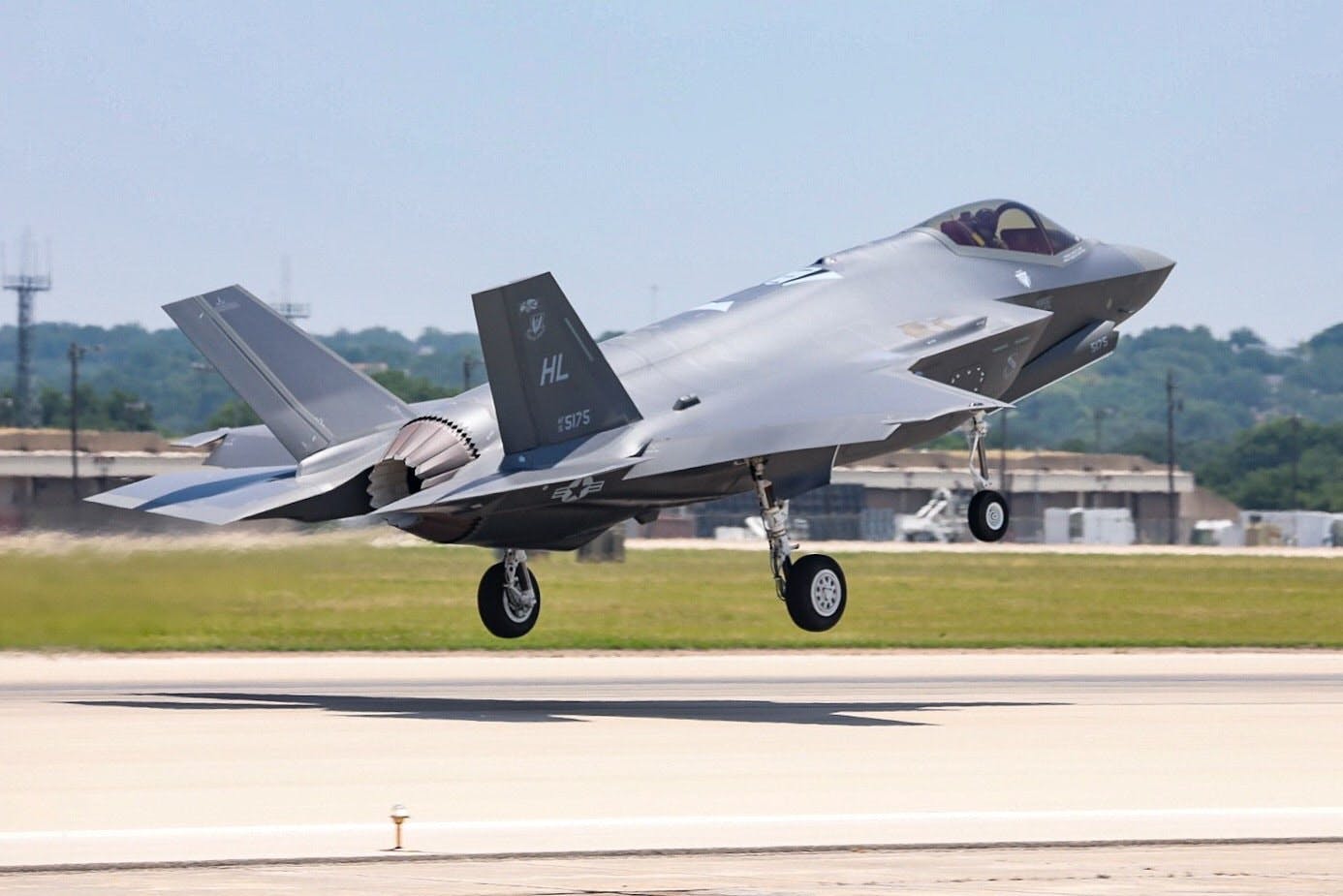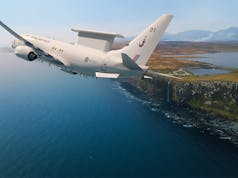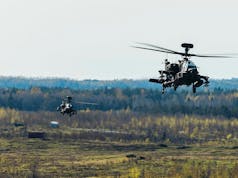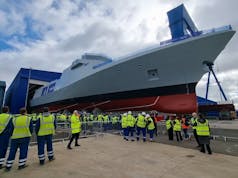The F-35 Joint Program Office and Lockheed Martin have delivered the 300th production F-35 aircraft.
The 300th aircraft is a U.S. Air Force F-35A, to be delivered to Hill Air Force Base, Utah.
“The F-35 weapons system is a key enabler of our National Defense Strategy and is providing our warfighters the combat proven, advanced capabilities they need to meet mission requirements,” said Vice Admiral Mat Winter, program executive officer for the F-35 Joint Program Office.
“The 300th production aircraft delivery is a significant milestone that highlights the effective F-35 Enterprise collaboration across the JPO, U.S. services, partners and industry. Moving forward, our F-35 team remains committed to driving costs down, quality up and faster delivery timelines across our development, production and sustainment lines of effort.”

The first 300 F-35s include 197 F-35A conventional takeoff and landing (CTOL) variants, 75 F-35B short takeoff/vertical landing (STOVL) variants, and 28F-35C carrier variants (CV) and have been delivered to U.S. and international customers. More than 620 pilots and 5,600 maintainers have been trained, and the F-35 fleet has surpassed more than 140,000 cumulative flight hours.
“This milestone is a testament to the hard work and dedication of our joint government and industry team as we collaborate to deliver transformational F-35 capabilities to the men and women in uniform,” said Greg Ulmer, Lockheed Martin vice president and general manager of the F-35 program.
“We are focused on reducing costs, increasing efficiencies, and ensuring the highest level of quality as we ramp to full rate production and sustainment of the operational fleet.”
As production volume increases and additional efficiencies are implemented, Lockheed Martin is on track to reduce the cost of an F-35A to $80 million by 2020, which is roughly equal to or less than legacy 4th generation aircraft.
With the incorporation of lessons learned, process efficiencies, production automation, facility and tooling upgrades, supply chain initiatives and more, the F-35 enterprise has already significantly reduced costs and improved efficiency say the defence giant.
For example:
- The price of an F-35A has come down more than 60 percent from the first contract.
- Touch labor has been reduced by about 75 percent over the last five years.
- Production span time has decreased by about 20 percent since 2015.
The F-35, they say, met its 2017 delivery target of 66 aircraft, representing more than a 40 percent increase from 2016. In 2018, the team is targeting 91 aircraft deliveries and is preparing to increase production volume year-over-year to hit a rate of approximately 160 aircraft in 2023.













It’s worth noting that F35 airframe is rated for 8000 hours vs 6000 for standard gen 4 and 2000 for certain Russian models.
Even at the same unit price that makes F35 cheaper.
Isn’t this always the case with new aircraft ? With F22 and Typhoon there was lots of sensational crap in the media until the aircraft enter service and everyone realises what world beaters these are.
Same for the Tornado MRCA, if you believed the rubbish they printed about that aircraft in the 70s you would have wondered if it could ever get off the runway.
good, now we can order more for the fleet air arm
From what I’ve read though, it will be expensive to maintain. That’s where Lockheed will make its money.
It’s massively complex next gen software. That means it needs its operating system updating like an iPhone. Unlike Apple, those software updates won’t be included in the purchase price.
(Chris H) Ian – except that the UK has full autonomy over and access to software in our F-35s. Its about the only thing Tony Blair got right …
And given we write most of that software we will benefit from further upgrade work LM carries out on customer aircraft.
Only the USA could deliver 300 aircraft and still be in Low Rate Initial Production.
I don’t know how much automation is employed during the building of the airframe? If one compares the level of hands-off assembly, currently being used in car manufacturing. Is there not a huge time saving to be had on later versions of this plane, and the 5th generation, if automation is widely introduced?
about time ‘hank the yank’ pulled his finger out and got our order done.
Read an article today about Israeli F-35s operating over Lebanon with four Luneberg Radar reflectors fitted so that Russian radars could not detect the real stealth radar signature of the aircraft. In other words, never go stealthy until it’s absolutely necessary to do so, so that when you do, they don’t realise you’re coming cause they haven’t clocked what your actual signature looks like. Simple but clever.
Also read the same information, apparently they don’t want the Russians monitoring F35 operations in stealth mode so they develop measures to detect the aircraft.
The photo of the Israeli F35 flying over Beirut clearly shows the radar reflectors in place.
The same as American F-22 intercepts of Russian bombers using external drop tanks to make them very visible.
F-35B Block 4 software upgrades will cost Britain £345m
https://www.theregister.co.uk/2018/03/22/f_35b_block_4_upgrades_cost_uk_345m/
That’s seems pretty cheap considering how many UK weapons are in block 4.
Operating aircraft at the very limit of human technology costs money and with the size of F35 program everything seems expensive until you realise how much you are getting and how many platforms it’s repalcing.
I’m sure maintainance cost will be higher for F35 than for gen 4 aircraft but that’s very normal, gen 4 cost a lot more to maintain than gen 3 and so on.
F35 is much cheaper to maintain than F22 as it does not have to mess about with the coatings etc.
At the moment chinas J20 can barley leave its climate controlled hanger due to stealth coatings.
4.5% of total costs? Cheap at the price. And I suspect more upgrades will follow. That’s the point of this aircraft. It’s an ICT programme that just happens to fly combat missions. It cannot be looked at or judged by traditional standards. It will be subject to continuous upgrades based on testing and operational feedback (at least I hope it will, otherwise it will become obsolete pretty quickly and that would be a massive waste of money!). And as for MoD not having planned all these costs and spares and support costs into the programme, that’s a load of tosh! The RAF will a have a SRO (senior responsible officer – Air Comodore rank I suspect) who is responsible directly to the SecState for programme delivery. He will chair monthly review meetings with all the associated DLODS (defence lines of development) to monitor progress of each and see that they are all delivering their bit in accordance with the Capability Milestones of the overall programme. One will be IOC. Another will be FOC. there will be another one in there such as first overseas operational deployment, etc., etc. One of the CMs will be called something like Logistic Support Date, or similar. That’s the date by which all the Lines of Development required come together to ensure that the aircraft and the capability it represents are supportable in a reliable and sustainable basis. Before you can reach any of these milestones you need to have a fully funded programme, i.e. each DLOD has to have funding allocated. The DLODS are usually comprised of such lines of development as Training, Equipment, Personnel, Infrastructure, Doctrine, Organisation, IT and Logistics and usually known by the acronym TEPIDOIL, although it can vary from programme to programme. Not all DLODS have to deliver at the same time or are as critical to delivering capability so funding lines will vary in time and value. But they will all be funded even if the money may not yet be available for one of them in the budget (fiscal year). These DLODS are of course kept under constant review as are the funding lines. So it will not be true that MOD doesn’t know how much it will cost to support the aircraft or how much spares will cost, but the exact cash amounts may have to vary from year to year depending on new information becoming known. Monies may have to be increased, decreased, brought forward or delayed depending on progress. One final point. The predicted MTBUR (mean time between unscheduled removal) of a key LRU (Line Replaceable Unit) may in practice and with hindsight turn out to be not as long as was originally predicted, in which case your stock holding of those spare parts may have to increase requiring an overspend in one particular area (unless you’ve got guarantees under the contract covering such things or you are contracting support on a Power by the Hour basis). I’m not surprised MOD remains tight lipped about such things. It’s too early in the day to make definitive statements that will inevitably turn out to be wrong giving the press another opportunity to knock the programme!
as the only level 1 partner in the project, other than the aircraft, and spin off employment around the country, what are we getting, other than the aircraft themselves?
It’s not the hardware thats the problem, it’s the cost of updating and maintaining the software.
This is going to be expensive
Makes me think we might have been better off having a slice of the software workshare rather than lift fans or rear fuselage!
Wasn’t access to the source code a huge bone of contention early on with one or more people in the US Senate (I think it was one main person) trying to block UK access and the UK saying it would pull out as a Tier 1 partner if it didn’t get access. I think it ended up as a very serious face-off. Who blinked first? Do we have access to the source code?
In terms of lines of code I believe the F-35 software is pretty much the biggest ongoing software development project out there right now.
Julian it’s increasingly true about anything ‘high – tech’ you buy from the US. But if you think that was bad wait till we want to upgrade our aircraft that will be the seventh circle of hell.
As opposed to Typhoon which has been dead easy to upgrade with its decade late radar etc, getting the Germans to pay for stuff is simple.
We won’t need to do a solo upgrade on F35 we will just tap on with the USMC.
We won’t be allowed to do a solo upgrade on the F35. We’ll have to keep the US DoD happy and US aerospace most of the work whatever price they see fit to charge.
I did read somewhere that BAE was involved in software development, but to what extent I do not know.
My guess software up dates are going to be very profitable for LM in the long term.
I know the UK wanted access to source codes back the mid 2000s when Labour was in government, not sure how that worked out. At one point, a defence minister said the UK would pull out of the project and buy Rafael instead!
“In March 2006, Paul Drayson, then Britain’s minister for defense procurement, told the U.S. Senate Armed Services Committee that Britain might quit the program if the United States withheld such things as the software code.
The issue rose to the top. In May 2006, then-President George W. Bush and then-Prime Minister Tony Blair announced that both governments had agreed “that the UK will have the ability to successfully operate, upgrade, employ, and maintain the Joint Strike Fighter such that the UK retains operational sovereignty over the aircraft.”
labour in government? ee gads, pass me my tablets!
I suspect we have both. The software that controls the lift fan, thrust vectoring rear nozzle and side thrusters I suspect is provided by RR as part of a package. That will have to interface with the rest of the flight control software and I hate to think what the interface control documentation and protocols look like! I also suspect that RR and BAES, like all other suppliers, will be contributing to the ALIS system with their own software packages and interfaces. A total nightmare I should think. As I said before, this is an IT programme first and foremost that just happens to fly…
I spent so time with Ferranti computer systems, for every person they employed on hardware they employed 5 on software developments in the late 80s.
I am sure that ratio has only increased in favour of software since then.
I was involved with Ferranti in the early 80s in that one of the primary test platforms for one of the products being developed in the office where I was based was a big Ferranti system so whenever I went down to the computer room to do my stuff on a VAX there was also a big Ferranti mainframe on the other side of the glass in our computer room.
Had you been at Ferranti in the early 80s I wonder whether you would have had a similar experience to the one we had in my office in 1982. The software I mentioned included amongst its users the Argentinian Navy which makes me wonder if they also had Ferranti hardware. They actually had the cheek (or balls) to log a support call with us DURING the Falklands war asking for help with a software issue. I can still remember a guy from our support desk coming in and saying to one of the managers “I’ve just had a support request from the Argentinians, what should I do?”. I think at the time we simply ignored it but I wonder whether if we’d been more cyber-warfare-aware at the time we shouldn’t have taken the call and used it as a vehicle to send them a malicious patch that would have seriously disrupted their operations. (I think networks were nowhere near connected enough at the time for it to have been possible to have injected spyware that could send info back to the UK which obviously would have been even better.)
Ah, Ferranti. Along with ICL & Acorn Computers those are companies that were once notable players in the global IT hardware business but are alas no more. (Well, Acorn’s biggest IP contribution to the world lives on in ARM but that is now Japanese owned.) There are probably others that deserve honourable mentions but for me those are the big ones. Maybe Sinclair too but I think Acorn had a wider international footprint at the height of its success, in fact in large part it was Acorn’s ambitions to conquer America that led to its demise.
I was involved in the Ferrari ADAWS and CACS projects in the mid to late 80s after leaving the army.
Most of time are Bracknell and Portsmouth, also spent sometime on Type 42 and the carriers who where equipped with ADAWS.
Didn’t really enjoy it so moved on, before Ferrari went bust.
That should be Ferranti, damn auto correct.
Would have enjoyed it and not moved on had it been Ferrari!
i haven’t understood a word in the 100 odd sentences above, but, there again i was a grease monkey on the antrim in 1982.
Isn’t $80 mill equivalent to around £65 million? That sounds very cheap. Don’t we pay around £100 mill per Typhoon? I think the case for a mixed fleet is getting stronger. If F35 b is around £100 million and we split the remaining 90 equally to the A & B variant we would save £1.5 billion. More than enough to cover running the extra type and we get greater performance as a result.
I believe the £100 million for Typhoon includes development cost and I think the $80 million is a clean unit price for F35. Not sure if the $80million includes th engine as well.
However once F35 ramps up especially if a second engine option gets added on prices should drop to 4th gen fighter levels although I think getting it to F16 price will never happen.
build another t45 with the savings please
Or we could sell our whole fleet of typhoons to the Germans for 65m each and replace 1 for 1 with an a version and go all in on F35.
We still need a MADL configured Taranis that can be sent deep into enemy territory by the F35 from a stand off postion.
The 138 F35b are to re-generate carrier strike, clearly we really need an operation force of 64-96 to kit each carrier out with 32/48 aircraft, but we also need spare, etc so I suspect the 138 is really the minimum to have a force of this size.
So that leaves Typhoon and Tornado, these should be replaced by F35 and Taranis.. numbers tbd.
is there enough room for all those f 35’s on the QE ? i’d have thought the aircraft numbers quoted to date, were mainly choppers.
is there enough room for all those f 35’s on the QE ? i’d have thought the aircraft numbers quoted to date, were mainly choppers. by the way, other than the f 35’s for traing at fort worth, how many f 35b’s do we have at the mo?
andy – I think there is ample room on the QE’s for any combination of F35’s and Helicopters we are likely to have in the near future,but to answer your question so far as I know we have had 15 F35 delivered to date,4 now at RAF Marham,5 more to arrive in August which leaves 6 left in the US for testing and training duties.